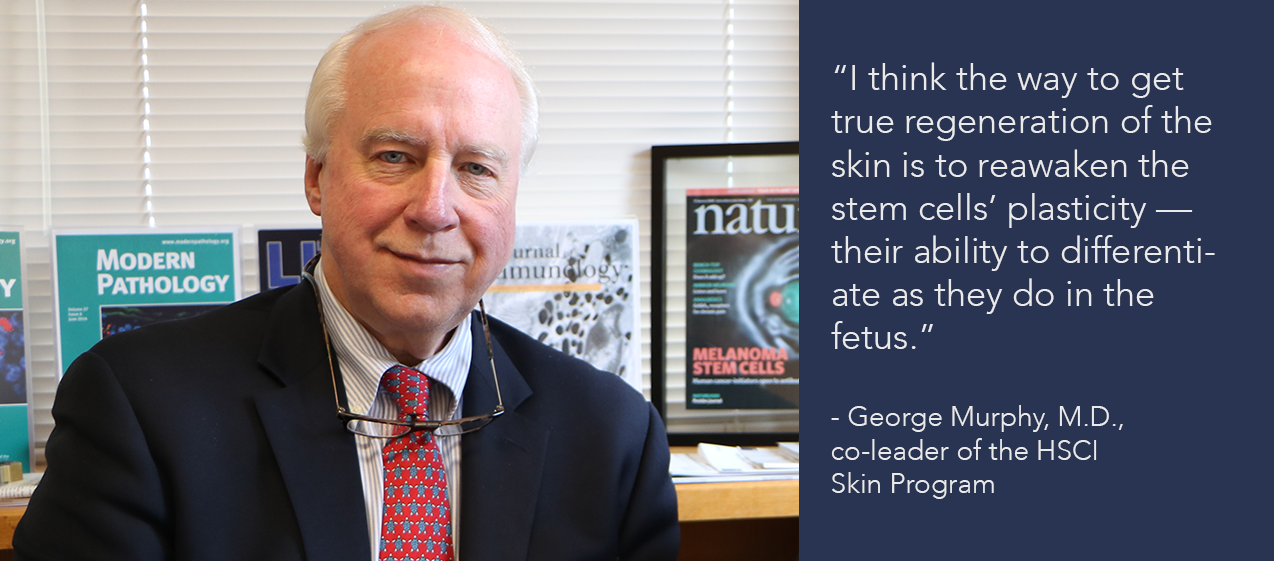George Murphy wants to use stem cells to replace scarring with regenerative healing.
- George Murphy’s goal is to coax skin stem cells into healing wounds by regenerating tissue instead of forming a scar.
- To figure out how to do it, he is studying scarless healing during fetal development and “stem cell burnout” during aging.
- Insights into scarless healing will help research into regenerating other vital organs, including the heart.

George F. Murphy, M.D., Professor of Pathology, Harvard Medical School, Director, Program in Dermatopathology, Brigham and Women's Hospital, and co-lead of the HSCI Skin Program.
Our bodies use an imperfect process to heal wounds. When an organ is damaged, it makes sense for a scar to form as quickly as possible to prevent fluid loss and replace lost cells. But scars are made of fibrous tissue rather than the original tissue types, so organs start to lose functionality:
- Scars on the cornea can result in vision loss.
- Scars on the skin mean reduced elasticity and may produce contractures and keloids.
- Scars on the heart lower its ability to pump blood.
As a co-leader of the HSCI Skin Program, George Murphy, M.D. wants to replace scarring with regenerative healing. His goal is to use stem cells to regenerate healthy, functional tissue. To achieve it, he is exploring fetal development and aging.
Restoring true regenerative healing
A pathologist by training, Murphy is fascinated by the ability of the human fetus to regenerate tissue. Although the process of prenatal regeneration is not well understood, its effects are evident in cases such as fetal heart surgery.
“Surgeons can use microscopes to go into the uterus, form a cut in the chest wall of the fetus, and repair the cardiac defect,” said Murphy. “Because the surgery is done prenatally, the babies are born without a scar.”
After birth, wound healing becomes a different story. “The skin has a really hard time regenerating. It usually forms a scar of fibrous connective tissue, which often contracts, and it's not a functional piece of tissue,” said Murphy.
Losing perfection
Healing a wound without scarring is no small feat. To regenerate functional tissue, stem cells in the skin must convert into many structures.
“They need to differentiate into nerves, into blood vessels, into epithelium and mesenchyme,” said Murphy, referring to different types of tissue.
The switch between regenerative healing and contractile scarring happens at some point around the time of birth, and Murphy wants to understand how this happens.
“I think the way to get true regeneration of the skin is to reawaken the stem cells’ plasticity — their ability to differentiate as they do in the fetus,” said Murphy.
The skin as it ages
Murphy is particularly interested in skin regeneration in the context of aging. “Wound healing and skin regeneration are much more relevant to older populations than to younger populations,” he said. “For example, non-healing leg ulcers are a big problem with elderly individuals.”
But even without the severity of a wound that does not heal, the skin changes with aging.
“The top layer of the skin gets much thinner. The lower layer also becomes thinner. Even the subcutaneous fat layer becomes thinner,” said Murphy. “And when we look at healthy young versus wrinkled, thinned, and fragile older skin, we see a depletion of stem cells that is age-related.”
Murphy hypothesizes that the depletion of skin stem cells during aging is related to the skin’s decreased ability to heal wounds. Along with other faculty in the HSCI Skin Program, he is investigating the biological mechanisms responsible for this phenomenon.
“Nobody has done a really deep dive into the mechanisms of skin stem cell burnout during aging, so I’m excited to push our understanding further,” he said.
Dr. Murphy has been a longtime collaborator with Dr. Markus Frank, most notably in the area of corneal and skin ABCB5-positive stem cells.
Beyond skin deep
The skin is a major organ, the largest in fact, in the human body, but Murphy also sees it as an experimental paradigm. “If we understand regenerative healing at the level of the skin, we will have critical insights into other vital organs,” he said.
As Murphy dissects how stem cell plasticity works in the skin, he hopes the findings will be broadly applicable to regeneration in other organs — including the heart, brain, kidney, and blood.
The power of the HSCI network
For Murphy, HSCI is more than just a place to get bold scientific questions funded.
“HSCI is a wonderful resource, because Seed Grants give opportunities to ideas that might not otherwise be funded,” he said. “But I would never say that it’s all about resources. Big scientific advances start with the right investigators, the right level of commitment, and synergistic concepts.”
Murphy has found precisely this combination in the HSCI Skin Program. “When we formed the program, I was reenergized,” he said. “We have this incredible consortium of investigators from multiple institutions, who have common interests but all take different approaches. It's been amazing."
Further information
Read about the HSCI Skin Program
Information for patients: ISSCR
